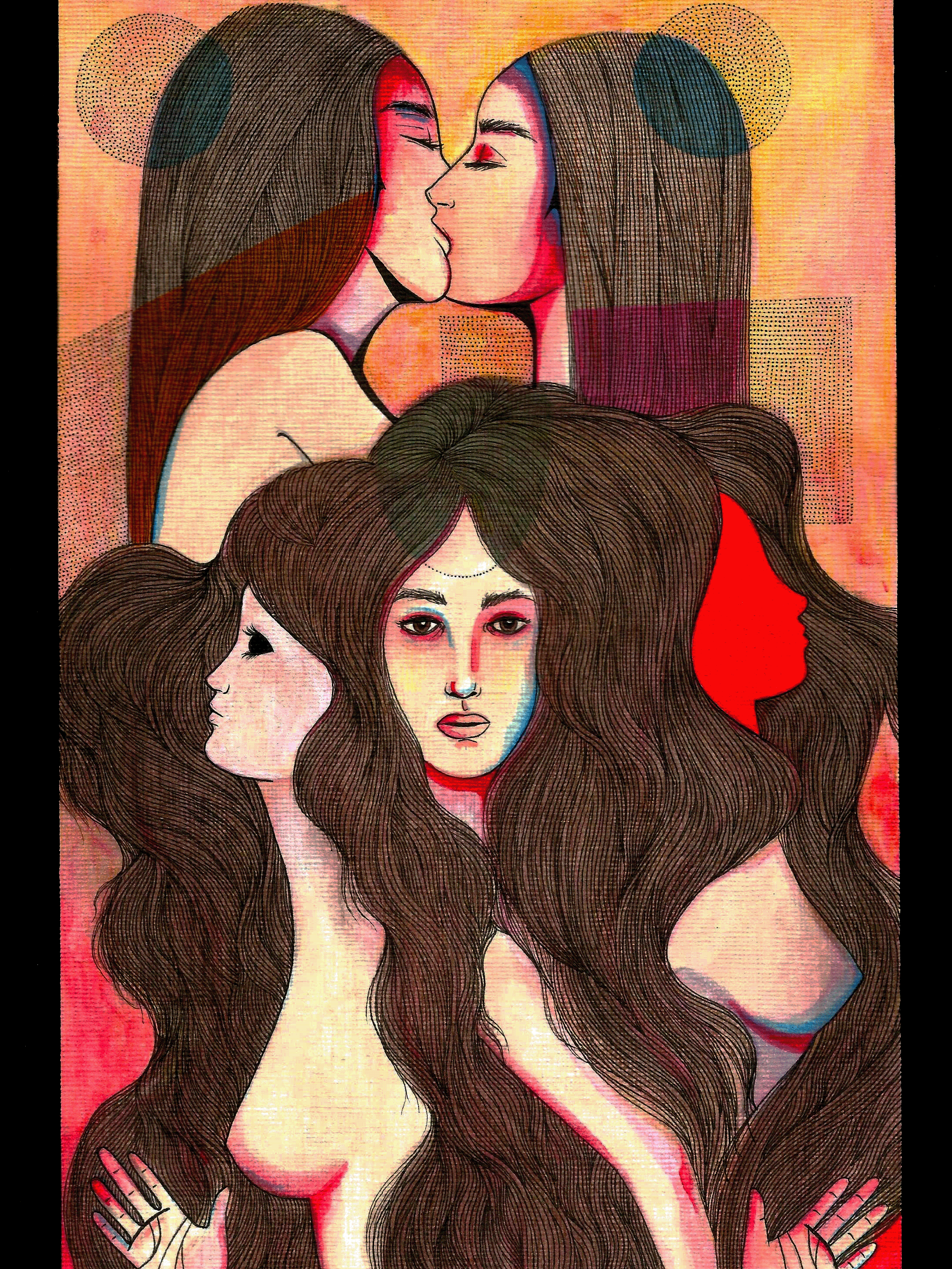As Amazonas da Taquara | 21 x 29.7 cm | ink on paper | 2022
As Amazonas da Taquara (The Riders of Taquara) is inspired by the painting The Riders of the Sidhe (1911) by John Duncan, this work is considered to be his masterpiece. ‘It is an iconic image of the late 19th-century Celtic revival – a movement that evoked the ancient cultural identities of Scotland and Ireland.'
'The painting depicts the Sidhe, or the Celtic Fairies, a divine race who inhabit the Otherworld of the dead; perceived only in visionary states of mind and usually at liminal places such as stone circles, sacred groves, wells, and 'fairy hills' or 'fairy glens'. In my version of this painting, elements of Brazilian and Irish mythology intertwine and many similarities between both folklores can be observed.
In my painting, she is replaced by my father as a child representing here Saint George, as he holds the spear and is about to kill the dragon.
As amazonas da Taquara depicts me, my mother and sisters riding horses instead of the original male figures in Duncan's work. In the original painting, the only female figure seen appears fragile, as if she waits to be rescued by the male riders.
Next to my father, we see me and my mother riding in the front. I am holding a basket offering the world in its conception, cracked open like a fragile egg, exposed. The genesis of the genesis.
'In the drawing, I appear riding a mula-sem-cabeça, which is a character from Brazilian folklore. In most tales, represents the ghost of a woman who was cursed for having given herself away to a priest and was condemned to be transformed into a headless mule that has fire instead of a head, galloping through the fields from sunset until sunrise.
Next to me is my mother holding a Saint George's sword plant and she is the only one riding a unicorn in the image. Symbolising the weapon used by Saint George in his battle against a dragon, this plant carries great mystical value, such as protection, and courage, and is also a great amulet to attract prosperity to your home. She marches bravely in the front and if one quick gesture seizes my father’s crown. She deserves it more than anyone.
By my feet, we see the Astra, she is the one.
The source, the genesis, she has been my tender mother when I needed one the most. She always gave me a reason to come back home too, despite all my great efforts to stay away as much as I could.
She was always the reason to come back. She taught me patience, serenity, love, companionship, support, reliance, kindness… all my best traits were defined by her life in mine. She is everything and that’s why she lives everywhere within me, and my art.
In the back, we see my eldest and youngest sisters. My older sister is carrying a child on her back as she is often celebrating the energy of the erês.
In Umbanda, it is believed that erês are spirits of evolved children who have not yet incarnated and who are very close to the Orixás, transmitting their wisdom. The erês appear to balance the energy of the place and transmit the message of the ruling Orixá. Therefore, in a very pure way, they can speak the truth bluntly and ask inappropriate questions, typical of an innocent child. In this context, my older sister also symbolises Saint Christopher, who is the patron saint of travellers, including motorists, who sometimes hang a small image of him in their vehicle for luck.
My youngest sister is riding a mustang. 'Mustang horses are known for having a wild nature, but they can be tamed and ridden like other horses. However, this process will take longer if they are taken directly from the wild as they are not used to being handled by people.' She has a tempestuous personality and I tend to associate her with the energy of Obaluauê, who is the orixá of the renewal of spirits, lord of the dead, and regent of cemeteries; considered to be the holy field between the material and spiritual worlds.
On the bottom right, we see Caer Ibormeith resting by the tree.
"She is the Celtic Goddess of Dreams, Prophecy, and Sleep. She was a shapeshifting goddess who spent one year as a beautiful woman and then the next year as a swan.' Swans appear frequently in Celtic mythology, often connected with a goddess, they are associated with love, purity, the soul, and music.'
'On the top of the tree, there is the Puca which is a phantom fairy creature that features Celtic folklore and fairytales of Ireland. Known for its cunning and wile as well as lies and deception, Puca’s archetype is the trickster. It is also a fertility spirit since it has the power to create or destroy, as well as the ability of human speech, being a gifted prophesier.' The drawing is an homage to my family and the people who I love. Is a celebration of Umbanda, of Exu, and mostly o povo de rua. Who have always been and will always be there for me. To read the full work's description, please check here.









